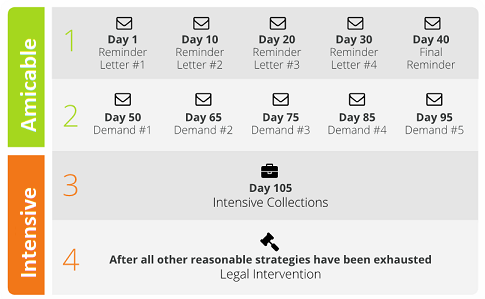As a full-time dentist and businessperson with a solitary dental practice, you are obligated to borrow values from both professions to form a devised strategy to effectively run your business. You are aware that a business establishment does not run on “debit” and that you will need all finances to be straightened out in order to keep your practice from hitting the bottom of the barrel. But dental practices have been following a painstaking financial liability scheme for some time; one that involves accounts receivable.
Accounts receivable (A/R) can be a tricky financial situation for a dental office, on one hand, you want the value-add to your clients of an assignment office but on the other, more negative hand, you don’t want to drown into the thousands of dollars in an A/R balance. Money conversations involving A/R balances are common in dentistry. In most dental practices, the teams have money conversations with patients as many as five times before reaching a resolution and having the monetary spends handed over. It can get very difficult to collect your A/R balance if you are not super focused and strict about receiving them.
Keeping that in mind, we have come up with a list of the best tips and tricks on how you can prevent an A/R balance and how to tackle one if it has been recorded in your bill books. Stop chasing signatures for checks and get paid quicker with these hacks.
1. Make sure the patient’s information is up-to-date
A/R problems can be combated head-on if you have a proactive system for organizing your patient’s details. The main reason why dental practices accumulate a large sum of A/R over time is that their check-in process is inept or incomplete. Make sure your patient’s information is up-to-date in your system. This includes verifying their address, pre-authorized form of payment, insurance information, etc. You need to also ensure that you have communicated to your patient their portion of the cost uncovered by insurance.
The more information you have about your clients, the easier it is to file claims and actually get paid due to it. Otherwise, you will be chasing ghosts or filing claims that are dotted with outdated policies. Double-check all your records, preferably when the patient checks in prior to the appointment.
2. Pre-estimate the insurance with your patient’s insurance company
The next key step to doing away with A/R claims is for you to check-in with the patient’s insurance company. You will also need to make a few calls here and there to pre-authorize the procedure with your client’s insurance company. Doing this lets you be in the loop of how much of the expense will not be covered by insurance. Keep a credit card on file for every patient and get access to use it. This is a great way to clear out small patient portion balances. But, in doing so, make sure you have a safe and secure way to store it as well as legal authorization to use it.
3. Discuss the treatment plans with patients upfront
Reducing A/R balances in your billing system entails a comprehensive approach for you to communicate to the patients the need and importance of a complete fee. For this, you will have to make your patients understand the need for treatment and recognize what the procedure can do for them in clear detail. This meeting is crucial for your patients as well as your practice as you are essentially “selling” treatment to a patient with their own consent and understanding. Long-term preventive care and treatment are the hardest to convince your patient to avail of.
You need to learn to talk to your patients as you would a family member or friend to emotionally connect and empathize with their personal and financial circumstances. Be the patient’s advocate and convey to them the benefit of completing payment head-on. These small, seemingly insignificant interactions about payoff can lead to less time spent collecting fees and more appointments to fill your calendar.
4. Educate your patient on the insurance charges
A lot of patients who come into your clinic are not aware of their insurance coverage and their benefits. You will have to educate your patients about their coverage benefits and its different tiers, levels, copays, inclusions, and allowances. Even if the patient has scanned his or her plan, there may still be some limitations and inconsistencies that are not obvious in the plan summary. By talking to your patients about their insurance, you are in a way relating to the patient’s issues which would give you an opportunity to connect with your patient.
5. Provide third-party patient financing
Instead of providing patients with payment plans and struggling to collect them, try offering third-party patient financing as a way to manage your practice A/R. Use two or three different companies to help finance the patient. But be careful to do your research and make sure that you are working with a reputable company that will add value to your patient experience. Doing this selectively will create patient loyalty and allow them to accept the treatment that they need, which will help boost your case acceptance. You will be prioritizing your patient’s needs over your own by this action due to which your patients will be more likely to stay with you and refer.
6. Employ insurance verifier technology
Insurance verifier technology allows you to visualize up-front which codes require claim attachments to adjudge a claim. Reviewing claim attachment requirements before submitting a claim as this helps you provide or attach appropriate documents such as perio-charts, x-rays, as other procedural documents, in advance. Doing this up-front will help you get paid quicker and not have your A/R balance crank up. In cases where you may not attach verifying case attachment documents with your claims, there is a huge possibility that the payer may reject your claim due to a lack of required documentation. Installing an insurance verifier technology helps save time and keeps revenue surging.
7. Bill frequently, Remind promptly
Consider billing on a net-15 or net-10 basis instead of the customary practice of waiting 30 days. By being on top of your patient’s monthly obligations, you will naturally get more payments. You can contact your patients through their preferred media – be it email, call, text, and so on. It is important to contact your patients if you do not hear from them even after billing.
- Patients that are 30 days overdue or under can be easily tackled by having a credit card on file. In case you do not have a credit card on file, give your patient a call every few days to remind them of the payment.
- Payments that are between 30 and 60 days overdue can be harder to collect but with a strategized communication plan, it can be combated.
- Payments that are over 90 days overdue can be a challenge to collect. Give the patient a call every other day for the first 10 days. If the issue has not been resolved by then, you could send a letter each week for the next three weeks. If neither phone calls nor request letters work, you may try mailing a demand letter.
8. Hire a collection agency to collect your fees
Alternatively, you can hire a collection agency to contact your patients about their payments so that you do not look vicious and “money-hungry”. If you have noticed that your staff has been contacting your patients frequently, it is time to outsource to a collection agency who will attempt collection on your behalf. These collection agencies will charge anywhere between 20 to 40% of what they collect.
Know your numbers and take action accordingly. Implement any of these strategies to help lower your A/R balance and get paid faster!



